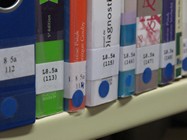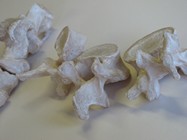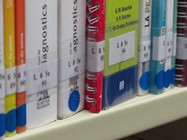Centre de Documentation Gilly / CePaS-Centre du Patrimoine Santé
HORAIRE
Lu : 8h15 à 12h00 - 12h30 à 16h15
Ma : 8h15 à 12h00 - 12h30 à 16h30
Me : 8h15 à 12h00 - 12h30 à 16h15
Je : 8h15 à 12h00 - 12h30 à 16h30
Ve : 8h15 à 12h00 - 12h30 à 16h15
Fermetures exceptionnelles les mardi 22 avril (en matinée) et 13 mai
Lu : 8h15 à 12h00 - 12h30 à 16h15
Ma : 8h15 à 12h00 - 12h30 à 16h30
Me : 8h15 à 12h00 - 12h30 à 16h15
Je : 8h15 à 12h00 - 12h30 à 16h30
Ve : 8h15 à 12h00 - 12h30 à 16h15
Fermetures exceptionnelles les mardi 22 avril (en matinée) et 13 mai
Bienvenue sur le catalogue du
Centre de documentation de la HELHa-Gilly
et du CePaS - Centre du Patrimoine Santé
Centre de documentation de la HELHa-Gilly
et du CePaS - Centre du Patrimoine Santé
Détail de l'auteur
Auteur L. Pennel |
Documents disponibles écrits par cet auteur


 Ajouter le résultat dans votre panier Faire une suggestion Affiner la recherche
Ajouter le résultat dans votre panier Faire une suggestion Affiner la rechercheDonnées actuelles sur le GHB, la GBL et le 1,4-BD / M. Dematteis ; L. Pennel ; M. Mallaret in La revue du praticien, Tome 62, n°5 (Mai 2012)
Titre : Données actuelles sur le GHB, la GBL et le 1,4-BD Titre original : (Current knowledge on gammahydroxybutyric acid (GHB), gammabutyrolactone (GBL) and 1,4-butanediol (1,4-BD)) Type de document : texte imprimé Auteurs : M. Dematteis ; L. Pennel ; M. Mallaret Année de publication : 2012 Article en page(s) : 669-672 Langues : Français (fre) Mots-clés : DROGUES DE SYNTHESE GHB GBL TYPE OF USE TYPE D'USAGE PHARMACOKINETICS PHARMACOCINETIQUE TOXICITY TOXICITE PHARMACOLOGY PHARMACOLOGIE METABOLISM METABOLISME EFFET RECHERCHE SYMPTOM SYMPTOME Résumé : FRANÇAIS :
Le gamma-hydroxybutyrate (GHB) est un vieil anesthésique qui a été mésusé dans les années 1980-1990 comme anabolisant (bodybuilding), drogue récréative (ébriété, effets euphorisants, désinhibiteurs, aphrodisiaques) et agent de soumission chimique (effets désinhibiteurs, hypnotiques et amnésiants). Sa consommation dans la population générale reste faible, et touche principalement les populations gays (nightclubs) et les jeunes (lieux festifs). Les intoxications, surtout en cas d'association à l'alcool, peuvent être graves, avec coma et dépression respiratoire, voire fatales. L'usage chronique induit une dépendance psychique et physique ; les syndromes de sevrage peuvent être sévères, avec agitation et délire. En 1999, le classement du GHB comme stupéfiant s'est accompagné d'une augmentation de la consommation de ses précurseurs, la gamma-butyrolactone (GBL) et le 1,4- butanediol (1,4-BD), qui étaient facilement accessibles dans le commerce comme solvants et produits nettoyants. Comme le GHB, leur marge d'utilisation est étroite, avec une toxicité similaire. L'augmentation de leur consommation à visée récréative, et des cas graves d'intoxication, d'abus et de dépendance a conduit le ministre de la Santé à interdire, en 2011, leur cession et leur vente au public.
ENGLISH:
Gamma-hydroxybutyric acid (GHB) is an old anaesthetic drug which was misused in the 80-90's as an anabolic agent (bodybuilding), recreational drug (drunkenness, euphoric, disinhibiting and aphrodisiac effects) and as a date rape drug (disinhibiting, hypnotic and amnesic effects). Its use in the general population is low, and mainly concerns gay population in nightclubs and young people in parties. The intoxications, above all with alcohol combination, can be severe, with coma and breathing depression, or even fatal. Chronic use leads to psychic and physical dependence; withdrawal syndrome can be severe, with agitation and delirium. In 1999, GHB classification as a narcotic resulted in the increased use of GHB prodrugs gamma-butyrolactone (GBL) and 1,4-butanediol (1,4-BD), which were easily commercially available as solvent and cleaning products. Like GHB, they have a narrow window of use, and share similar toxicity. Their increased cases of recreational use and of severe drug intoxication, abuse and dependence, led the French Ministry of Health in 2011 to prohibit their sale and transfer to the public.Permalink : http://cdocs.helha.be/pmbgilly/opac_css/index.php?lvl=notice_display&id=25945
in La revue du praticien > Tome 62, n°5 (Mai 2012) . - 669-672[article] Données actuelles sur le GHB, la GBL et le 1,4-BD = (Current knowledge on gammahydroxybutyric acid (GHB), gammabutyrolactone (GBL) and 1,4-butanediol (1,4-BD)) [texte imprimé] / M. Dematteis ; L. Pennel ; M. Mallaret . - 2012 . - 669-672.
Langues : Français (fre)
in La revue du praticien > Tome 62, n°5 (Mai 2012) . - 669-672
Mots-clés : DROGUES DE SYNTHESE GHB GBL TYPE OF USE TYPE D'USAGE PHARMACOKINETICS PHARMACOCINETIQUE TOXICITY TOXICITE PHARMACOLOGY PHARMACOLOGIE METABOLISM METABOLISME EFFET RECHERCHE SYMPTOM SYMPTOME Résumé : FRANÇAIS :
Le gamma-hydroxybutyrate (GHB) est un vieil anesthésique qui a été mésusé dans les années 1980-1990 comme anabolisant (bodybuilding), drogue récréative (ébriété, effets euphorisants, désinhibiteurs, aphrodisiaques) et agent de soumission chimique (effets désinhibiteurs, hypnotiques et amnésiants). Sa consommation dans la population générale reste faible, et touche principalement les populations gays (nightclubs) et les jeunes (lieux festifs). Les intoxications, surtout en cas d'association à l'alcool, peuvent être graves, avec coma et dépression respiratoire, voire fatales. L'usage chronique induit une dépendance psychique et physique ; les syndromes de sevrage peuvent être sévères, avec agitation et délire. En 1999, le classement du GHB comme stupéfiant s'est accompagné d'une augmentation de la consommation de ses précurseurs, la gamma-butyrolactone (GBL) et le 1,4- butanediol (1,4-BD), qui étaient facilement accessibles dans le commerce comme solvants et produits nettoyants. Comme le GHB, leur marge d'utilisation est étroite, avec une toxicité similaire. L'augmentation de leur consommation à visée récréative, et des cas graves d'intoxication, d'abus et de dépendance a conduit le ministre de la Santé à interdire, en 2011, leur cession et leur vente au public.
ENGLISH:
Gamma-hydroxybutyric acid (GHB) is an old anaesthetic drug which was misused in the 80-90's as an anabolic agent (bodybuilding), recreational drug (drunkenness, euphoric, disinhibiting and aphrodisiac effects) and as a date rape drug (disinhibiting, hypnotic and amnesic effects). Its use in the general population is low, and mainly concerns gay population in nightclubs and young people in parties. The intoxications, above all with alcohol combination, can be severe, with coma and breathing depression, or even fatal. Chronic use leads to psychic and physical dependence; withdrawal syndrome can be severe, with agitation and delirium. In 1999, GHB classification as a narcotic resulted in the increased use of GHB prodrugs gamma-butyrolactone (GBL) and 1,4-butanediol (1,4-BD), which were easily commercially available as solvent and cleaning products. Like GHB, they have a narrow window of use, and share similar toxicity. Their increased cases of recreational use and of severe drug intoxication, abuse and dependence, led the French Ministry of Health in 2011 to prohibit their sale and transfer to the public.Permalink : http://cdocs.helha.be/pmbgilly/opac_css/index.php?lvl=notice_display&id=25945 Exemplaires (1)
Cote Support Localisation Section Disponibilité Revue Revue Centre de documentation HELHa paramédical Gilly Salle de lecture - Réserve Exclu du prêt










